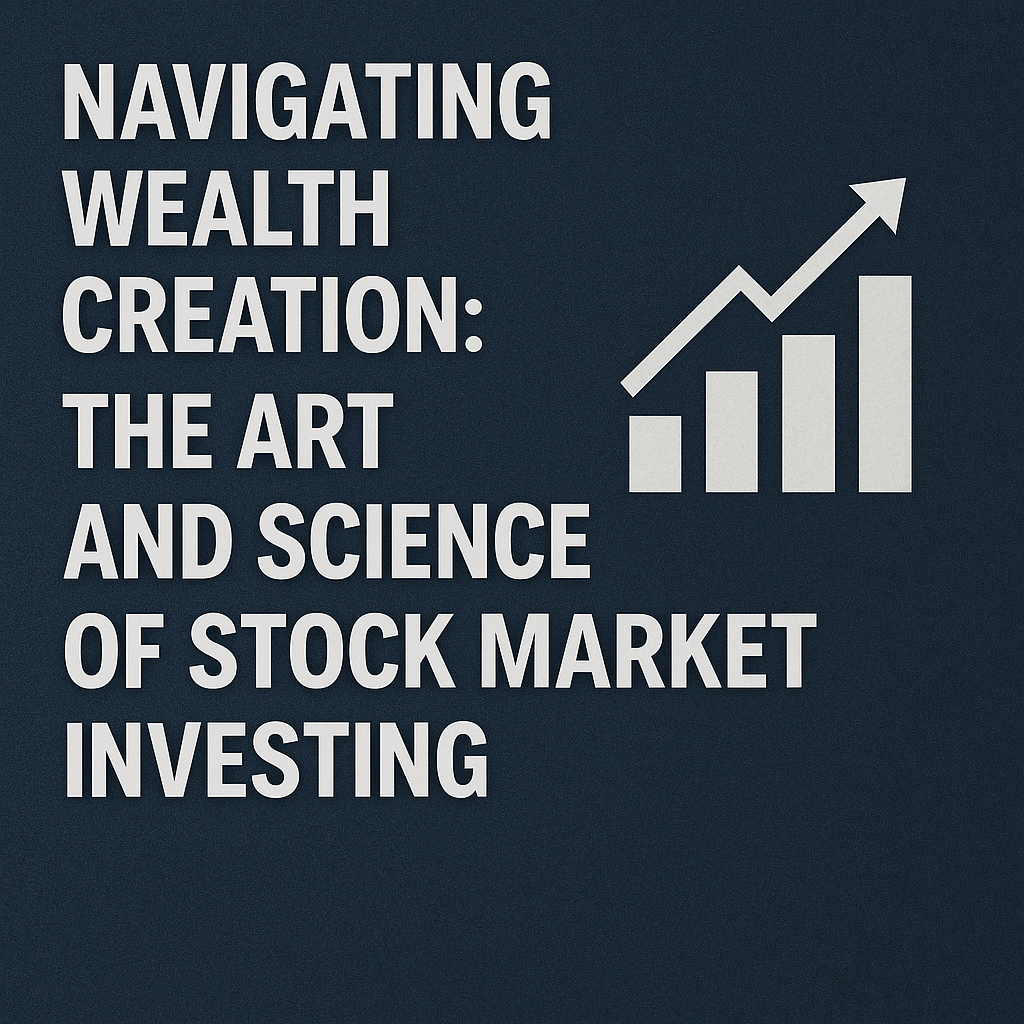The stock market has long been a cornerstone of wealth creation, offering individuals the opportunity to grow their financial portfolios through strategic investments. Investing in stocks, however, is both an art and a science, requiring a blend of analytical rigor, emotional discipline, and an understanding of market dynamics. As of April 1, 2025, the global stock market continues to evolve, shaped by technological advancements, economic shifts, and changing investor behaviors. This essay explores the fundamentals of stock market investing, the strategies for success, the risks involved, and the future outlook for investors, providing a comprehensive guide for both novice and seasoned investors aiming to navigate this complex yet rewarding landscape.
Understanding the Basics of Stock Market Investing
At its core, investing in stocks involves purchasing shares of ownership in publicly traded companies. When you buy a stock, you become a shareholder, entitled to a portion of the company’s profits (often distributed as dividends) and potential appreciation in the stock’s value over time. Stocks are traded on exchanges like the New York Stock Exchange (NYSE) or Nasdaq, where prices fluctuate based on supply and demand, influenced by factors such as company performance, economic conditions, and market sentiment.
The primary goal of stock market investing is to achieve capital appreciation—buying stocks at a lower price and selling them at a higher price. Additionally, many stocks pay dividends, providing a steady income stream. For example, blue-chip companies like Apple or Microsoft have historically offered consistent dividends alongside long-term growth, making them attractive to investors seeking both stability and returns.
To begin investing, individuals typically open a brokerage account, which serves as a platform to buy and sell stocks. Modern brokerages like Charles Schwab, Fidelity, or Robinhood offer user-friendly interfaces, low fees, and educational resources, making stock market investing more accessible than ever. However, accessibility does not guarantee success; understanding the market’s intricacies is crucial for making informed decisions.
Strategies for Successful Stock Market Investing
Successful stock market investing requires a well-thought-out strategy tailored to an individual’s financial goals, risk tolerance, and investment horizon. Here are some key approaches:
- Fundamental Analysis: This strategy involves evaluating a company’s financial health by analyzing its balance sheet, income statement, and cash flow. Investors look at metrics like the price-to-earnings (P/E) ratio, earnings per share (EPS), and revenue growth to determine whether a stock is undervalued or overvalued. For instance, a low P/E ratio compared to industry peers might indicate a stock is a bargain, as was the case with Tesla in early 2020 before its meteoric rise.
- Technical Analysis: Unlike fundamental analysis, technical analysis focuses on historical price patterns and trading volumes to predict future movements. Investors use tools like moving averages, relative strength index (RSI), and candlestick charts to identify trends and entry/exit points. For example, a stock breaking above its 50-day moving average might signal a bullish trend, prompting investors to buy.
- Diversification: Spreading investments across different sectors, industries, and asset classes reduces risk. A diversified portfolio might include stocks from technology, healthcare, and consumer goods, as well as bonds and real estate. During the 2022 market downturn, investors with diversified portfolios were better insulated against losses compared to those heavily concentrated in tech stocks.
- Long-Term Investing: The buy-and-hold strategy, popularized by investors like Warren Buffett, emphasizes holding stocks for years or decades to benefit from compounding returns. For instance, an investment in Amazon at its 1997 IPO, despite numerous market crashes, would have yielded exponential returns by 2025, showcasing the power of patience.
- Dividend Investing: This approach focuses on stocks with consistent dividend payouts, providing passive income and stability. Companies like Procter & Gamble, with a history of increasing dividends for over 60 years, are popular among dividend investors seeking reliable cash flow.
Risks and Challenges in Stock Market Investing
While the stock market offers significant opportunities, it also comes with inherent risks. Market volatility, driven by economic events, geopolitical tensions, or unexpected crises, can lead to sharp declines in stock prices. For example, the 2020 COVID-19 pandemic caused a rapid market crash, with the S&P 500 dropping over 30% in a matter of weeks before recovering later in the year.
Another risk is company-specific factors, such as poor management decisions, declining revenues, or legal issues. The collapse of companies like Enron in 2001 and more recently, the struggles of firms like Peloton in 2023, highlight the importance of thorough research before investing.
Emotional decision-making poses a significant challenge for investors. Fear and greed often drive irrational behavior, such as panic-selling during a market dip or buying into a speculative bubble. The GameStop frenzy of 2021, fueled by retail investors on platforms like Reddit, demonstrated how herd mentality can inflate stock prices unsustainably, leading to losses for late entrants.
Inflation and interest rate changes also impact stock valuations. In 2022, the U.S. Federal Reserve’s aggressive rate hikes to combat inflation led to a sell-off in growth stocks, as higher interest rates reduced the present value of future cash flows. Investors must stay informed about macroeconomic trends to adjust their strategies accordingly.
The Role of Technology and Innovation
Technology has transformed stock market investing, making it more efficient and accessible. Online trading platforms, robo-advisors, and mobile apps have lowered barriers to entry, allowing retail investors to participate alongside institutional players. Artificial intelligence (AI) and machine learning are increasingly used for predictive analytics, helping investors identify patterns and optimize portfolios. For instance, firms like BlackRock leverage AI to analyze vast datasets, giving them an edge in decision-making.
Blockchain technology and tokenization are also reshaping the market. By 2025, some companies have begun exploring tokenized stocks, where shares are represented as digital tokens on a blockchain, enhancing transparency and reducing settlement times. This innovation could democratize access to private companies, traditionally reserved for venture capitalists.
Future Outlook for Stock Market Investing
As of April 1, 2025, the stock market continues to evolve amid global economic shifts. The rise of sustainable investing, driven by environmental, social, and governance (ESG) criteria, has gained traction, with investors prioritizing companies that align with their values. Firms like Tesla and Vestas, leaders in renewable energy, have seen increased interest from ESG-focused funds.
Geopolitical tensions, such as ongoing trade disputes between the U.S. and China, and economic recovery post-inflation surges, will likely influence market dynamics. Emerging markets, particularly in Asia and Africa, present growth opportunities as their economies expand and stock exchanges mature.
The integration of cryptocurrencies into traditional portfolios is another trend to watch. With institutions like Fidelity offering Bitcoin and Ethereum ETFs, and banks like SGKB providing crypto trading services, the lines between traditional and digital assets are blurring, offering investors new avenues for diversification.
Conclusion
Investing in the stock market is a powerful tool for wealth creation, but it demands knowledge, discipline, and a long-term perspective. By understanding the fundamentals, adopting sound strategies, and staying attuned to market trends, investors can navigate the complexities of the stock market and achieve their financial goals. While risks are inevitable, they can be mitigated through diversification, research, and emotional resilience. As technology and global dynamics continue to shape the investment landscape, those who adapt and innovate will be best positioned to thrive in this ever-evolving arena. Whether you’re a beginner or a seasoned investor, the stock market offers a journey of growth, learning, and opportunity—if approached with the right mindset.




